|
Dinner success with Ria, the Japanese student: cheese tortellini and Ragu sauce. Which I would never buy - not because I am a snob, but because it answers the question “What would ketchup be like with much more sugar?” It was “Flavored with Meat,” a rather vague assertion, and as far as I could tell contained no particles of anything that could be identified as proper cow parts, but it was a hit. Tomorrow we’re supposed to surprise her with Kentucky Fried Chicken. Problem: no KFCs anywhere around. The true American Experience is supposed to have the Colonel and the bucket, and if I arrive with Popeye I will have to explain how a grizzled sailor with absurdly musckled forearms came to be associated with fried chicken.
Picked her up at school and took another student as well. Different social circles, you can tell. Took the scenic route around the lakes, which are just gorgeous now, astonishingly so - all the colors of the trees, the broad bowls of blue. The people jogging along the paths. The fox.
The fox? Cars had slowed on the parkway for no discernible reason, but then I saw it. A fox, running along the jogging path, tail straight back, intent on something. They cooed with delight: kawaii!
Earlier that day they’d been at the Mall of America. Now the winding road around the lakes, with fox. Along the parkways past houses great and small. Another day in America. I wonder what they think. I have the impression the other student, being more stylish and self-possessed, will go home and be even more awesome to her peers because she went to the greatest mall in the world and brought home a bag from Victoria’s Secret. And our student, in her quiet way, will keep the memory close and go on with her life and never leave Japan again. You can’t tell; you can’t say. She seems a mild and private type. Perhaps she will always remember the fox, harried, intent, running the opposite direction from everyone else on the path.
And the pumpkin ice-cream sandwiches.
Architecture / modern art rant follows. Lots of Product below if you wish to skip. Another one of those write-and-post-without-editing things; it’s late and I want to watch Fringe.
If you missed the work blog on Monday - posted late, due to computer problems; the software choked on a Larry King Drakehands Vine, which might mean nothing to you whatsoever - then you missed some architectural preservationist musings. They’re ripping down an ugly building in Chicago, but since it’s iconically ugly and represents the “circular Brutalist” mood of a particular style of architecture that was jammed down the city’s throat like a roll of sodden paper towels, it’s a tragedy. I’m not saying it should be demolished; it’s not my town. And of course I am not broken up by its breaking up because I have no fellow-feeling for the style, and have a hard time telling a landlord they are obliged to maintain an aesthetic aberration. You could say the building should stand as a cautionary tale, but no one ever learns the right lessons. I’m more interested in the people who celebrate it because they get a little shiver of pleasure from seeing something so different from its antecedents, and celebrate it because it’s a thumb in the eye.
Most of the celebrated modern buildings in old cities are ocular jabs first and foremost - prancing, preening things that would be a fascinating sight on an empty prairie, but look like things from dreams, fever swoons, big bright teetering things with matchstick protuberances and meaningless gashes where windows used to be. The classic forms are, apparently, no guide to the future; the fact that the Empire  State Building and the Chrysler building are emblems of New York, and that the Twin Towers was their only competitor simply because there were two, the ultimate minimalist sculpture, is lost on the moderns. And so you get this. State Building and the Chrysler building are emblems of New York, and that the Twin Towers was their only competitor simply because there were two, the ultimate minimalist sculpture, is lost on the moderns. And so you get this.
Some day I’ll see it in person, but right now I have to say: I hate this thing. Let me tell you why. Like most modern skyscrapers built in the West, it is more concerned with doing something than being something. I look at that building and I see something that’s turning away, as if to avoid a blow. One side has a point that pushes up: great! The other side has a point that pushes DOWN. Which, for a skyscraper, isn’t helpful.
Next to it you see a bit of the Cesar Pelli-designed group, which came along at the height of the classical phase of the Post-Modernists. It’s a bit blocky, but the entire project has heft and presence, and at least the roof does something. This building has a flat roof and it’s just pretending it does.
I was going to say something broad and silly like “every type of modern art has failed, except architecture,” but that sounds simplistic. Except it’s true. Atonal music? No one cares. Abstract painting? It had its vogue, reduced everything down to a canvas consisting of one color (Red #3 - a title of a Great Work, or an FDA additive designation?) Modern literature flirted with styles that required no particular aptitude - automatic writing, cutting up bits of newsprint and rearranging them - but words require structure, or it’s phoneme salad. Modern sculpture masked its irrelevance by substituting size for detail, so you’d be overwhelmed into thinking this enormous hunk of metal that looked like the Hulk broke out of a boxcar had significance, but eventually it turned into “installations” and “assemblages” that relied on the artist’s ability to recombine instead of create.
Architecture went modern and lanced the sky with futurist visions - first as populist creations drawn from illos in sci-fi pulps, then as dark stern boxes apt for the rise of the technocrats. In either case you sense a set of ideas, a set of aspirations. There is nothing in these modern buildings except the sense that computers have made it easy to twist a tower sideways and build it so it doesn’t topple over.
The first towers of modernism - in the late 20s and early 30s - fit. They wore the same stone clothes, they were massed like the towers that came before them. By shaving off the ornamental frosting they had a gravity of a Roman senator who takes all the braid off his toga; by boiling off the froth on the cornice they made the final leap into the clouds seem effortless. But since the 60s skyscrapers have either had a flat top, as if they banged their heads on an invisible ceiling designed to discourage would-be Icaruses. Except for the 80s. Except for the Post-Moderns.
I still remember the glee in the face of a bartender I worked with at the Valli. He was an architecture major, and they had to design a house. “I gave it a f***in’ hipped roof,” he grinned. You know, pointy on top, slanting down.
Being a revolutionary is necessary and romantic until the revolution has been achieved. After that shut up. History has reached its natural end and everything else is just refining the details.
Maybe that’s why I like the art of the waning days of the pre-WWI culture - Mahler’s great unraveling, Art Nouveau’s laudenum fumes, the Vaseline-on-the-eyeballs perspective of the Impressionists. It’s as if the entire culture sensed the dissolution to come, and wrote a love letter to all we would lose, capturing the essence of the old in the still-forming vocabulary of the new. A love letter and a suicide note, written in a room outside the square where they’re testing the guillotine on pumpkins.

WEEKLY BORDEN
For once, he’s happy - pre-Hemo, no less!
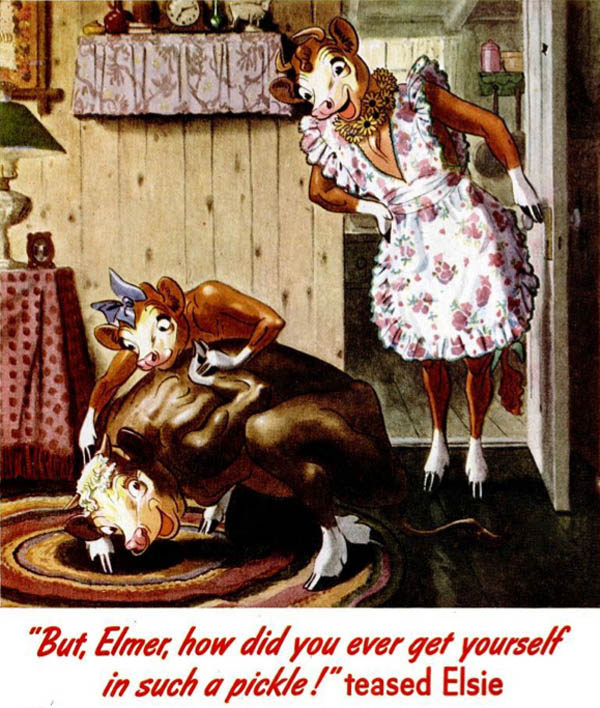
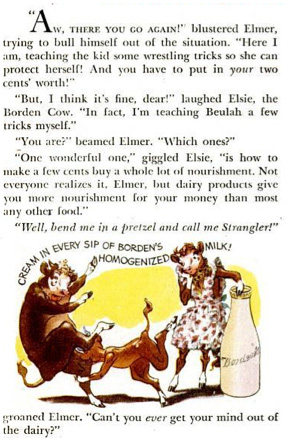
Then, as the text reveals, he’s immediately grumpy again, since Elsie spoiled some roughhousing with Beaulah. He also expresses his dismay that she can’t go 30 seconds without rubbing her Borden money in his face, and coins a phrase I think we all can understand: get your mind out of the dairy.
Everything below is from the Great Year of Hope and Doom 1939. There are certain years that fascinate me - 1912, 1939, 1947, 1958, 1962. The last year of the Thirties has the apogee of Thirties modernism, a style of pure machine beauty that saw its height in the World’s Fair. Everything that style suggested, every cultural aspiration, would sputter and expire. An internationalist ideal has a hard time surviving a global war.
First: three examples of car art, showing an angle you’d see if you were a mechanic or lying by the side of the road. It’s majestic stuff.



COPY THAT
The wonder of the age, the Mimeograph.
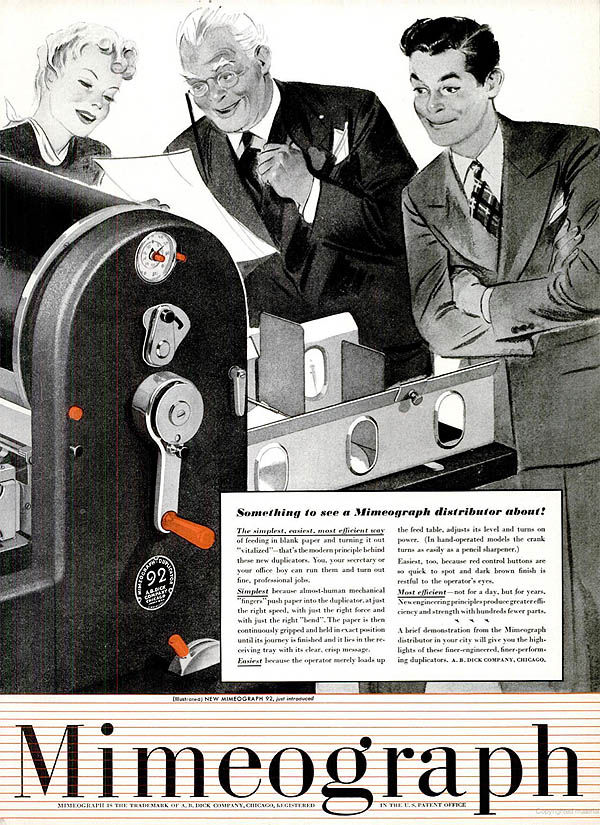
At this point the technology was over half a century old, and “Mimeograph” was used in an 1887 patent filing.
By the way: "Mistakes can be corrected by brushing them out with a specially formulated correction fluid, and retyping once it has dried. ('Obliterine' was a popular brand of correction fluid in Australia and the United Kingdom.)"
Someone needs to use that brand name for a line of spirits. Do not, however, mistake this machine for a Spirit Duplicator, which has its own wikipedia entry that includes the subhead “in 20th Century Folk Memory.”
The faintly sweet aroma of pages fresh off the duplicator was a memorable feature of school life in the spirit-duplicator era. A pop culture reference to this is to be found in the film Fast Times At Ridgemont High. At one point a teacher distributes a duplicated schedule of class quizzes, and every student immediately lifts it to his or her nose and inhales.
Mmmm, Methyl alcohol. I’ve said for years that if you brought back Ditto fluid as a cologne or perfume every single person over 45 would wear it.
KITCHEN FLOORS
Look at the Gorgon hair on the blonde:
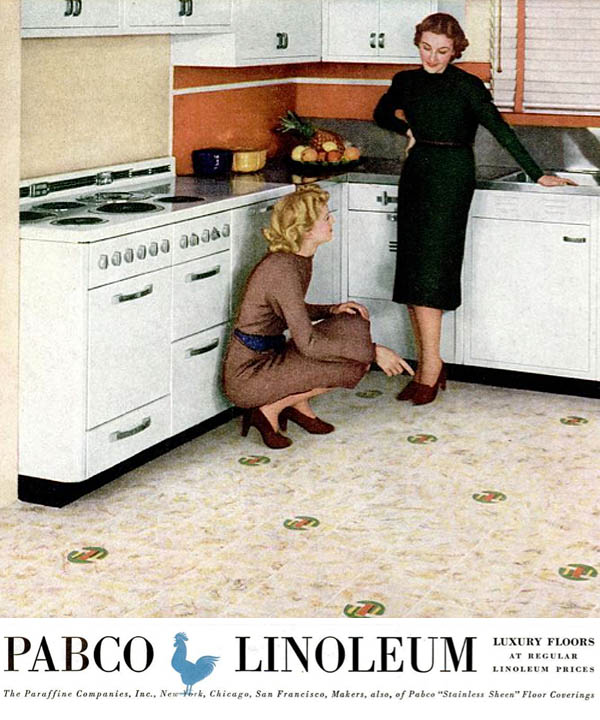
Pabco would be the company’s name in the 50s. Paraffine was the name for the group of companies owned by Fibreboard, which made paperboard. Pabco, though: what does that mean? Paper And Board Company, is my guess. It’s one of the names of the companies they bought. Also: this dead trademark refers to a product called “P & B,” so perhaps it’s P And B Company.
In any case, it’s a chic kitchen.
CALOX:
Before toothpaste, I gather, there was tooth powder. Calox used famous actress June Lang . . . hold on, no, I don’t know who she is, either.
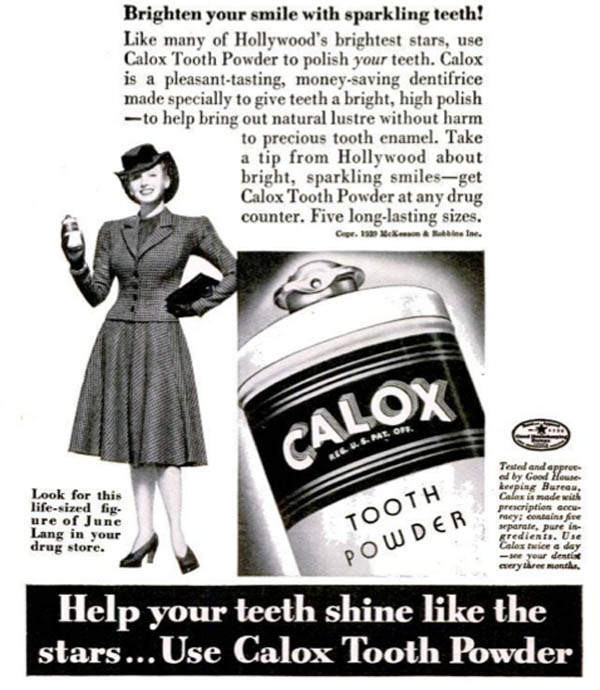
Well, she was in "Stage Door Canteen," along with a hundred others.
I use this it’s an excuse to show what stores looked like: they had a life-sized picture of Miss Lang. I wonder if she was in color.
Anyway: she was born here in Minneapolis, but her family moved west while she was a kid and got her into picures. She had a good run - but this was the end of her run, right here. It's an October 1939 campaign, and I don't think she had a contract at this point: "Fox sent June to England in 1938 to film So This Is London (1939) but the threat of war there so terrified her that she abandoned the set and returned home. Fox quickly ended her contract for making that choice." Ouch. But then she made a career-ending mistake: she married Handsome Johnny Roselli, a Chi-town racket man. Hollywood wanted nothing to do with that. She said she thought he was a producer, and cut him loose in '43, but her career never recovered.
1939 wasn't a good year for McKesson & Robbins, the makers of Calox, either, as they were no doubt recovering from the bad publicity generated by a financial scandal. The "McKesson & Robbins Scandal," to be precise. Never good when something like that's named after your company. In a nutshell: a crook took over the company, hired his brothers, cooked up a fake company, and diverted money to the shell firm. The crook was Phillip Musica, and he got his start selling hair extensions from a company he named U. S. Hair, the most amusingly named company I've heard in a while. "Good-quality hair sold for as much as $80 a pound. Musica had his mother gather up nearly worthless sweepings from barbershop floors. He then put them in crates with a layer of expensive hair on top." He made a million out of it, but the Feds caught up with him. Here it gets interesting.
He was then hired as a special investigator with the New York State Attorney General's office under the alias William Johnson. He spent most of the next three years chasing down suspected German spies and draft dodgers. However, his career ended when he tried to implicate William Randolph Hearst as a German collaborator. Musica was apparently trying to get back at Hearst for his unflattering coverage of the U.S. Hair scandal.
Yes, that was something of a mistake. After that came Prohibition and bootlegging, and he moved on McKesson & Robbins. By then he'd changed his name to F. Donald Coster. When he received words that the Feds had found out who he was, and what he'd been doing, he locked himself in the bathroom and took the lead exit. Wikipedia:
"He was careful to stand in a way that when he fell into a large marble bathtub, none of his blood stained the carpet on the floor."
BOO
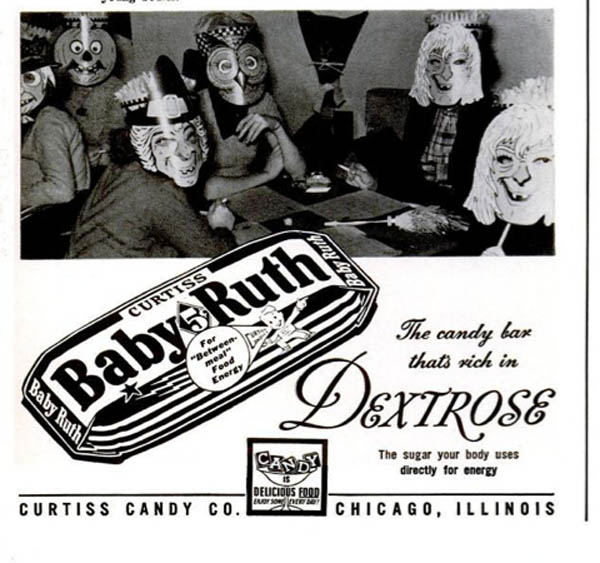
Yes, this was the sole concession to the existence of Halloween in 1939: a tiny little ad for Baby Ruth.
Either those are adults or children were smoking earlier than we thought.
Work blog around 12:30 and Tumblr as well. See you around. Oh: this week's update may look a bit different; I uploaded the entire Comic Sins 2014 version. All 300+ pages. All redone.
No small feat.
|

